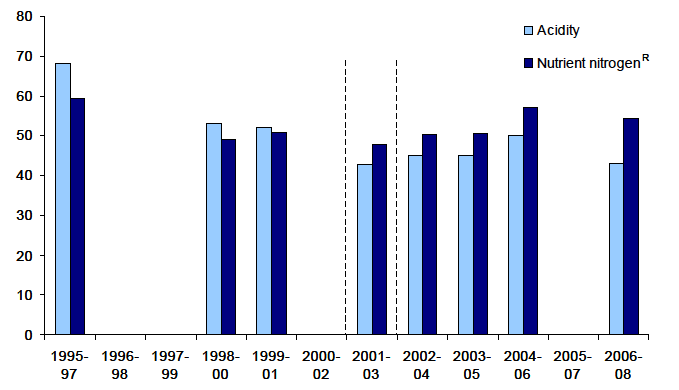Key Scottish Environment Statistics 2012
This publication aims to provide an easily accessible reference document which offers information on a wide range of environmental topics. It covers key datasets on the state of the environment in Scotland, with an emphasis on the trends over time wherever possible.
This document is part of a collection
Sensitive Habitats Exceeding Critical Loads for Acidification and Eutrophication[14]: 1995-1997 to 2006-2008
Percentage exceedance

Critical loads are thresholds above which the deposition of pollutants causing acidification (sulphur dioxide, nitrogen oxides and ammonia) and eutrophication (nitrogen oxides and ammonia) causes significant harm to the environment.[15] The pollutants come mainly from industry, transport and agriculture.
Around 60% of Scotland's land area contains habitats sensitive to acid deposition and 55% to eutrophication. Scotland experienced a reduction in acidity exceedance from 68% in 1995-1997 to 43% in 2006-2008, primarily due to reductions in sulphur emissions. This included a 7% reduction in acidity exceedance between 2004-06 and 2006-08. Following a period of increase between 2001-2003 and 2004-2006, nutrient nitrogen exceedance decreased by 3% between 2004-2006 and 2006-2008. Overall, nutrient nitrogen exceedance fell from 59% to 54% in the period 1995-1997 to 2006-2008.[16]
The EU National Emissions Ceiling Directive sets limits for emissions of ammonia, nitrogen oxides, sulphur dioxide and volatile organic compounds (VOCs) to be achieved by 2010. The Gothenburg Protocol (United Nations Economic Commission for Europe, 1999) also sets ceilings for these emissions. The UK ratified the Protocol in 2005.
Source: Centre for Ecology and Hydrology / Metadata
Contact
Email: Sandy McPhee
There is a problem
Thanks for your feedback